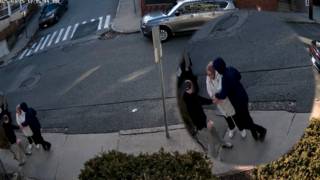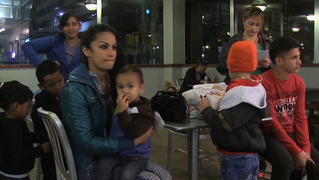
Guests
- Barbara Hinesformer director of the Immigration Clinic at the University of Texas Law School. Her affidavit in a lawsuit challenging detention of women and children as a method of deterrence to mass migration was cited by the federal judge in his order to halt the practice.
- Renée FeltzDemocracy Now! producer and criminal justice correspondent.
Watch our extended interview about detained migrant women seeking asylum in court via video stream, as they face harsh conditions in a private prison setting along with children as young as a few months old. We speak with Democracy Now! producer Renée Feltz about what she observed in the courtrooms in San Antonio, and with Barbara Hines, former director of the Immigration Clinic at the University of Texas Law School. Her affidavit in a lawsuit challenging detention of women and children as a method of deterrence to mass migration was cited by the federal judge in his order to halt the practice.
Watch Part 1 of this report which includes an on-the-ground video story from Texas and an interview with a mother and her son who were recently released on bond from detention.
AMY GOODMAN: This is Democracy Now!, democracynow.org, The War and Peace Report. I’m Amy Goodman, with Juan González.
JUAN GONZÁLEZ: Well, we’re continuing to look at President Obama’s expansion of the controversial practice of detaining mothers and their children. Starting last summer, thousands of Central American women with kids as young as a few months old crossed into the United States seeking asylum. Even though many were later found to have a credible fear of violent persecution, they found themselves rounded up and put into detention, with little chance for freedom until they were deported.
But last month a federal judge ordered immigration authorities to begin releasing the women and children. He found that the Obama administration’s policy of detaining them in order to deter others from coming into the country was illegal.
AMY GOODMAN: We’re joined again by Barbara Hines, former director of the Immigration Clinic at the University of Texas Law School. Her affidavit in a lawsuit challenging detention of women and children as a method of deterrence to mass migration was cited by the federal judge in his order to halt the practice.
Also with us, Renée Feltz, Democracy Now! producer, who has just returned from Texas, where she was reporting on family detention. And you can see her report in part one of this discussion.
Renée, I wanted to start with you. Can you describe your experience in the courtroom? What were these court cases about?
RENÉE FELTZ: Well, Amy, when I was in San Antonio reporting, I stopped by the federal immigration courts. They have rented out a floor in a commercial building in downtown San Antonio. There’s a hallway full of courtrooms, and I went into one to watch women appear remotely, by video stream, from detention centers that I went to. And in the courtroom, you had a judge, you had an interpreter, and you had a lawyer, in some cases, for the women, and then you had an ICE prosecutor for the government. And what I saw was women appearing before a judge and only hearing part of the trial, in which their life was being determined, interpreted for them. The part that was interpreted was the judge’s questions directly to them, nothing else. So they didn’t hear his responses or what the lawyers were talking about, about how their case would unfold. The judge didn’t actually have a gavel. He had a remote control with which he would control what the women saw.
I saw the judge reduce a lot of the women’s bonds in these cases in which they were saying that they have credible fear and want to seek asylum, but do it outside of detention. He reduced their bonds from $7,500 to about $4,000 in several cases, especially the ones where the women had lawyers. If they didn’t, they were much worse off. But I also saw him deny bonds to women who had been deported before. And it was an interesting Catch-22, because he would offer a bond to their child, but he would say that “you’re not eligible for relief.” So, your child’s release is conditional on your release; you’re not getting out, therefore your child’s not getting out.
JUAN GONZÁLEZ: But even a reduction of the bond to $4,000, when you’ve just come over the border with no belongings whatsoever, that must be a difficult hurdle for many of the asylum seekers to pass.
RENÉE FELTZ: It’s true. And a couple things about that. It isn’t always clear where the money’s coming from. Their families are desperate to get them out of detention and do what they can. In some cases, the women’s family can’t afford it. And there are some funds that have been set up that people are donating to that help them win relief. Now, one person I talked to—and I mentioned this in my video report—said that there were concerns that maybe the women were getting some help in paying their bonds from traffickers. And so, when they were released, they were perhaps going into sexual slavery. And this is a big concern, but I wasn’t able to confirm that, but I heard concerns raised.
AMY GOODMAN: Barbara Hines, can you weigh in here, as former director of the Immigration Clinic at the University of Texas Law School? What’s happening in these courtrooms and the issues that Renée has raised?
BARBARA HINES: Yes. I mean, before the lawsuits, because ICE, the government, opposed every single bond, it was a tremendous drain on legal resources. There are not enough pro bono lawyers, in the first place, to represent this population, and we were forced to fight every single case. Since the decision by the federal court, ICE has been setting bonds, but not in an individualized way as the judge required. ICE will set bonds between $7,500 and $10,000, which is far higher than what the judges are setting, forcing us once again to go into court to seek the reduction of bonds. Many women cannot pay the bonds. They are high, and they certainly are high for this population of asylum seekers.
And fortunately, we have had, with the work of the Interfaith Committee, in San Antonio a fairly generous bond fund, where members of the community have contributed. And that’s been the way that we have successfully been able to release women. But all of this procedure prolongs the detention of women, and it prolongs the detention of small children. It’s very, very stressful for the children, and it’s very, very stressful for the women. And we hear terrible, terrible stories of what’s happening to the mothers and their children while they are waiting to see whether they’re going to be released.
In regards to women that have not been—that are not eligible for bond because they have been deported before, that’s a very complicated legal issue that I’m not going to address here, but it just shows how ill-thought this policy is, that you’re going to say your child can be released with a bond, but you can’t. It once again shows to me why family detention cannot work. There’s not a humane way that we can operate a family detention center or a family detention program.
AMY GOODMAN: Renée?
RENÉE FELTZ: I fully agree with Barbara, and I know there’s a lot of concerns being raised about this in Texas. And there is a protest coming up on May 2nd, the Saturday after May 1st, where people from around the country are going to be gathering in Dilley to address this and to talk about what they want the Obama administration to do instead of detaining the women and children.
JUAN GONZÁLEZ: And, well, Barbara Hines, that’s what I wanted to ask you. Given the enormous resistance by the Congress to act on any kind of immigration reform, what would you hope that the Obama administration could do in the case of these families?
BARBARA HINES: Well, the Obama administration took the most extreme position in regards to these families, from a panoply of options of what to do with asylum seekers. Remember, these are asylum seekers. They have a right to apply and seek protection in our country. They cannot seek protection from their own country. They must appear and arrive at a border in our country to seek protection under the Refugee Convention. Before the incarceration of mothers and children, women could be released, with their children, to family members—almost all of the women coming have family members in the United States—with a notice to appear for their hearings, with alternative to detention reporting requirements, monitoring devices, going to holistic shelters, like Casa Marianella in Austin, Texas. There’s a range of alternatives that are so much cheaper and so much more economical than the amount of money that the government is now spending—and paying, of course, to prison companies for profit to detain women. All of this money could be spent on providing lawyers to refugee women that are coming, because the statistics show that appearance rates and success on asylum cases is intimately twined and dependent on access to legal counsel.
AMY GOODMAN: And what is the legality, Barbara Hines, of the description Renée just gave us of the courtroom where the women can’t even understand half of what is going on and they’re looking at the judge with a remote control in the judge’s hand through this video screen from the detention facility?
BARBARA HINES: Well, this is very problematic. It’s sort of one more part of the dehumanizing process that immigrant women go through. You’re not a person in front of a judge. It is a grave concern of mine that we do not have complete, simultaneous interpretation. That’s an issue that we are bringing up with the administration, because full participation and due process doesn’t mean that you just hear what the judge says, because of course, as a lawyer, there is so much that goes on between the lawyer and the judge, so many cues that your client can pick up on, understand what’s going on. But that is not what occurs in our immigration courts.
AMY GOODMAN: And you talked about the horrendous situation of particular cases you know about when women are being detained. Can you describe—can you describe some of those?
BARBARA HINES: Yes. For example, as I—we had a baby whose mother was told she couldn’t let her baby crawl—that baby was between three and six months—because it was dangerous, so she had to carry the baby around for six months.
We’ve had severe problems with medical care. The first case, early on, that we had was a child that had brain cancer. And ICE and the facility knew that she had brain cancer. They refused to provide any medical care to her, nor did they release her. And the only reason that she was released was because of the tremendous pressure that was put on by her lawyer and by the community advocates in Austin and nationally to have her released. So lack of medical care is a very grave problem there.
Threats by the GEO staff, and that is that if your child doesn’t behave, something bad is going to happen with the judge. But really—
AMY GOODMAN: The GEO staff is the private prison facility.
BARBARA HINES: Excuse me, excuse me. GEO is the company that runs Karnes. The Corrections Corporation of America runs the other facility, Dilley.
But really, I think the most sort of egregious, depressing part is that this is a deprivation of freedom. And it’s very hard to explain to young children that they can’t leave. They can’t walk out the door. And the uncertainties—what is going to happen to us, when are we going to leave? And, of course, these are children and moms who have gone through untold horrors and seen and suffered so much trauma in their home countries, only to face this here in our country.
JUAN GONZÁLEZ: And, Barbara Hines, we just have a couple more minutes, but the—even despite the judge’s order, there’s still an expansion of family detention going on in the country? And what’s the refugee flow been like in recent months?
BARBARA HINES: Well, the refugee flow is down, is quite down, other than the—even among the Central American mothers and children and the unaccompanied children, the children that come from Central America, primarily, without their parents. But immigration, overall, unauthorized migration is down to its lowest historical level. So, to kind of frame this as some mass migration crisis, I think, is wrong. Unfortunately, some of the expansion is fueled by the prison industry. They need to have these beds filled up. So I’m very concerned that there is going to be an expansion at Dilley.
AMY GOODMAN: In fact, Juan, you were talking about the historical significance of the area.
JUAN GONZÁLEZ: Well, Crystal City obviously was where, in the 1960s, there was a huge resurgence of Raza Unida party, and the beginning of the birth of modern political power for Latinos in the United States happened in Crystal City, a major battle over voting rights back then by the Mexican community in that time.
AMY GOODMAN: Well, we’re going to leave it there, and we thank you both for being with us. Barbara Hines, former director of the Immigration Clinic at the University of Texas Law School, and thanks so much to Democracy Now!'s very own Renée Feltz, who's just come back from Texas covering the detention facilities there. And thanks to Tish Stringer, as well. This is Democracy Now!, democracynow.org, The War and Peace Report. I’m Amy Goodman, with Juan González.











Media Options